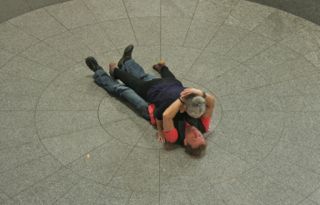Doubt corresponds with distance. To feel in our hearts and minds and bodies that God is removed from us, is equal to an experience of doubt.
On the other hand, faith corresponds with closeness. To feel in our hearts and minds and bodies that God is close to us, is to be in a place of faith and hope and joy.
If this is so, then the Song of Songs can be read (in a metaphorical reading of the text) as an experience of, and reaching toward, intimacy with God — an experience of, and reaching toward, faith. The opening words of the Song represent such an experience and reaching: “Let him kiss me with the kisses of his mouth.” Here doubt and distance would be displaced.
This week at the Musée d’art Contemporain (Montreal) I observed a piece of performance art by Tino Sehgal, entitled “The Kiss”. Sehgal’s work, according to the program notes, “never includes physical objects.” Further, “the immateriality of Sehgal’s work stems from an antipathy to the object and a political conviction about the excessive proliferation of goods in Western society.”
 “The kiss” is an 8 minute performance piece in which actors move in carefully choreographed movements from one positioned kiss to another – each kiss enacting a famous kiss in art history. The pieces is repeated throughout the museum’s opening hours. But what struck me (and now strikes me) about the performance piece is the way that it expresses not intimacy but distance. It does so in a variety of ways. It thus expresses, perhaps, the degrees of distance that may be experienced in the spiritual life. Or, our distance and doubt in relation to Christ.
“The kiss” is an 8 minute performance piece in which actors move in carefully choreographed movements from one positioned kiss to another – each kiss enacting a famous kiss in art history. The pieces is repeated throughout the museum’s opening hours. But what struck me (and now strikes me) about the performance piece is the way that it expresses not intimacy but distance. It does so in a variety of ways. It thus expresses, perhaps, the degrees of distance that may be experienced in the spiritual life. Or, our distance and doubt in relation to Christ.
Tbe first degree of distance is that between the couple/actors enacting the various kisses. The intimacy of the kiss is absent between them – this is mere portrayal. And, to immediately add a degree of distance, this is the portrayal of a kiss that is itself a portrayal (in art history) of another kiss. Here we are already twice removed from physical intimacy of the woman and man portrayed.
A third degree of distance lies in the fact that I as I walk through the lovely lobby of the MAC, observing “The Kiss”, I am merely an observer – this portrayed intimacy is in no way mine. I am very physically present to it, but it is not an intimacy for me.
For the reader of this blog, there is a fourth degree of distance, inasmuch as the reader has not walked through the lobby, or been in the physical presence of “The Kiss.” Its movement, life, and careful choreography are all lost in the static photograph that I took.
 Finally, a fifth degree of distance must be constructed, in the awareness that Tino Sehgal would no doubt be unimpressed that I have objectified this performance of “The Kiss” in one static moment – in a photograph. He eschews every presumption that the performance can be captured and turned into an object. Thus we could honour Sehgal’s assumptions by rendering the above photo in more a abstract (a more distant) form, as to the right.
Finally, a fifth degree of distance must be constructed, in the awareness that Tino Sehgal would no doubt be unimpressed that I have objectified this performance of “The Kiss” in one static moment – in a photograph. He eschews every presumption that the performance can be captured and turned into an object. Thus we could honour Sehgal’s assumptions by rendering the above photo in more a abstract (a more distant) form, as to the right.
Here, at the fifth degree of distance, at a high level of abstraction, our removal from the original moment of intimacy is decisive. Here we may wonder whether anything approaching the original intimacy is possible. This is the place of doubt and distance.
The opening words of the Song of Songs, “let him kiss me with the kisses of his mouth,” is a recognition of distance and doubt — and it is a wish that God would act to break through the degrees of distance for us. A wish that God would establish intimacy, as he has done in Christ.
And as we read the opening words of the Song, perhaps they are also an invitation for us to push through all the degrees of abstraction and distance and doubt that plague and shape us — seeking intimacy with God through the Spirit that Christ has breathed upon us. We start where we are. And can do no more, perhaps, that open ourselves (letting down our guard, being willing to let go of every degree of distance, doubt, and abstraction) so that faith and hope and intimacy might make their appearance.
Perhaps this is what spiritual practices are all about.
